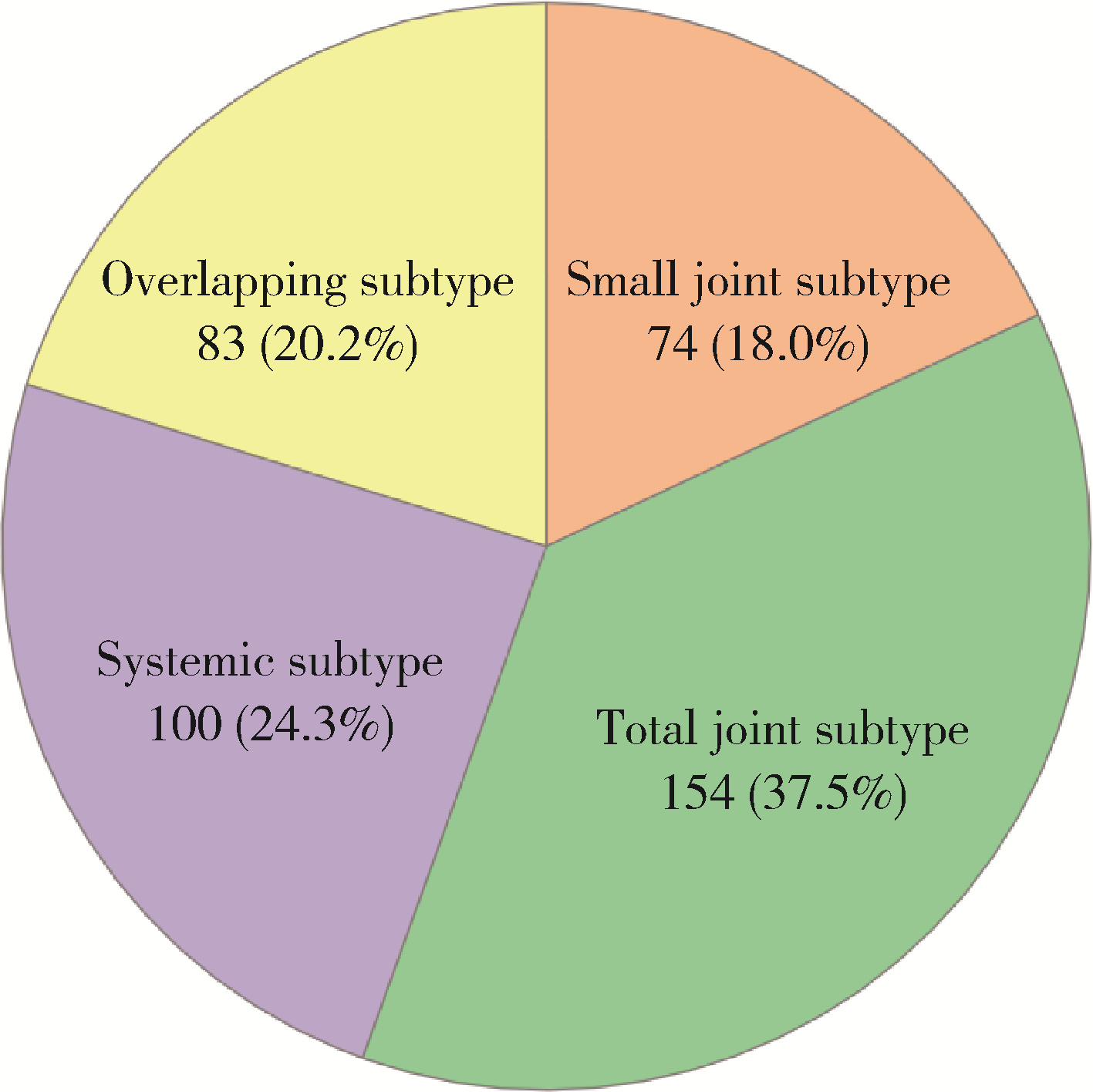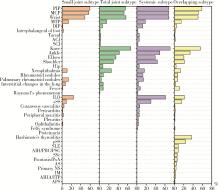Journal of Peking University (Health Sciences) ›› 2022, Vol. 54 ›› Issue (6): 1068-1073. doi: 10.19723/j.issn.1671-167X.2022.06.002
Previous Articles Next Articles
A cross-sectional study on the clinical phenotypes of rheumatoid arthritis
Wen-xin CAI1,Shi-cheng LI2,3,Yi-ming LIU1,4,Ru-yu LIANG1,Jing LI1,Jian-ping GUO1,Fan-lei HU1,Xiao-lin SUN1,Chun LI1,Xu LIU1,Hua YE1,Li-zong DENG3,*( ),Ru LI1,*(
),Ru LI1,*( ),Zhan-guo LI1,*(
),Zhan-guo LI1,*( )
)
- 1. Department of Rheumatology and Immunology, Peking University People's Hospital, Beijing 100044, China
2. Department of Oncology, the Second Affiliated Hospital of Soochow University, Suzhou 215123, Jiangsu, China
3. Institute of Systems Medicine, Chinese Academy of Medical Sciences & Peking Union Medical College, Suzhou Institute of Systems Medicine, Suzhou 215123, Jiangsu, China
4. Department of Rheumatology and Immunology, the Fifth Affiliated Hospital of Zhengzhou University, Zhengzhou 450052, China
CLC Number:
- R593.22
| 1 |
Turesson C , O'Fallon WM , Crowson CS , et al. Extra-articular disease manifestations in rheumatoid arthritis: Incidence trends and risk factors over 46 years[J]. Ann Rheum Dis, 2003, 62 (8): 722- 727.
doi: 10.1136/ard.62.8.722 |
| 2 |
Li R , Sun J , Ren LM , et al. Epidemiology of eight common rheumatic diseases in China: A large-scale cross-sectional survey in Beijing[J]. Rheumatology (Oxford), 2012, 51 (4): 721- 729.
doi: 10.1093/rheumatology/ker370 |
| 3 |
Zhou Y , Wang X , An Y , et al. Disability and health-related quality of life in Chinese patients with rheumatoid arthritis: A cross-sectional study[J]. Int J Rheum Dis, 2018, 21 (9): 1709- 1715.
doi: 10.1111/1756-185X.13345 |
| 4 |
Aletaha D , Neogi T , Silman AJ , et al. 2010 rheumatoid arthritis classification criteria: An American College of Rheumatology/European League Against Rheumatism collaborative initiative[J]. Arthritis Rheum, 2010, 62 (9): 2569- 2581.
doi: 10.1002/art.27584 |
| 5 |
Vij R , Strek ME . Diagnosis and treatment of connective tissue disease-associated interstitial lung disease[J]. Chest, 2013, 143 (3): 814- 824.
doi: 10.1378/chest.12-0741 |
| 6 |
Linn-Rasker SP , van der Helm-van Mil AHM , Breedveld FC , et al. Arthritis of the large joints, in particular, the knee, at first presentation is predictive for a high level of radiological destruction of the small joints in rheumatoid arthritis[J]. Ann Rheum Dis, 2007, 66 (5): 646- 650.
doi: 10.1136/ard.2006.066704 |
| 7 |
Drossaers-Bakker KW , Kroon HM , Zwinderman AH , et al. Radiographic damage of large joints in long-term rheumatoid arthritis and its relation to function[J]. Rheumatology (Oxford), 2000, 39 (9): 998- 1003.
doi: 10.1093/rheumatology/39.9.998 |
| 8 |
Lockshin MD , Levine AB , Erkan D . Patients with overlap autoimmune disease differ from those with 'pure' disease[J]. Lupus Sci Med, 2015, 2 (1): e000084.
doi: 10.1136/lupus-2015-000084 |
| 9 |
Wallace ZS , Zhang Y , Perugino CA , et al. Clinical phenotypes of IgG4-related disease: An analysis of two international cross-sectional cohorts[J]. Ann Rheum Dis, 2019, 78 (3): 406- 412.
doi: 10.1136/annrheumdis-2018-214603 |
| 10 |
Tarn JR , Howard-Tripp N , Lendrem DW , et al. Symptom-based stratification of patients with primary Sjögren's syndrome: Multi-dimensional characterisation of international observational cohorts and reanalyses of randomised clinical trials[J]. Lancet Rheum, 2019, 1 (2): E85- E94.
doi: 10.1016/S2665-9913(19)30042-6 |
| 11 |
Platzer A , Alasti F , Smolen JS , et al. Trajectory clusters of radiographic progression in patients with rheumatoid arthritis: Associations with clinical variables[J]. Ann Rheum Dis, 2022, 81 (2): 175- 183.
doi: 10.1136/annrheumdis-2021-220331 |
| 12 |
Vergne-Salle P , Pouplin S , Trouvin AP , et al. The burden of pain in rheumatoid arthritis: Impact of disease activity and psychological factors[J]. Eur J Pain, 2020, 24 (10): 1979- 1989.
doi: 10.1002/ejp.1651 |
| 13 |
Lee YC , Frits ML , Iannaccone CK , et al. Subgrouping of patients with rheumatoid arthritis based on pain, fatigue, inflammation, and psychosocial factors[J]. Arthritis Rheum, 2014, 66 (8): 2006- 2014.
doi: 10.1002/art.38682 |
| 14 |
Terao C , Hashimoto M , Yamamoto K , et al. Three groups in the 28 joints for rheumatoid arthritis synovitis: Analysis using more than 17 000 assessments in the KURAMA database[J]. PLoS One, 2013, 8 (3): e59341.
doi: 10.1371/journal.pone.0059341 |
| 15 |
Curtis JR , Weinblatt M , Saag K , et al. Data-driven patient clustering and differential clinical outcomes in the brigham and women's rheumatoid arthritis sequential study registry[J]. Arthritis Care Res (Hoboken), 2021, 73 (4): 471- 480.
doi: 10.1002/acr.24471 |
| [1] | Dongwu LIU, Jie CHEN, Mingli GAO, Jing YU. Rheumatoid arthritis with Castleman-like histopathology in lymph nodes: A case report [J]. Journal of Peking University (Health Sciences), 2024, 56(5): 928-931. |
| [2] | Huina HUANG,Jing ZHAO,Xiangge ZHAO,Ziran BAI,Xia LI,Guan WANG. Regulatory effect of lactate on peripheral blood CD4+ T cell subsets in patients with rheumatoid arthritis [J]. Journal of Peking University (Health Sciences), 2024, 56(3): 519-525. |
| [3] | Xiaofei TANG,Yonghong LI,Qiuling DING,Zhuo SUN,Yang ZHANG,Yumei WANG,Meiyi TIAN,Jian LIU. Incidence and risk factors of deep vein thrombosis in patients with rheumatoid arthritis [J]. Journal of Peking University (Health Sciences), 2024, 56(2): 279-283. |
| [4] | Xue ZOU,Xiao-juan BAI,Li-qing ZHANG. Effectiveness of tofacitinib combined with iguratimod in the treatment of difficult-to-treat moderate-to-severe rheumatoid arthritis [J]. Journal of Peking University (Health Sciences), 2023, 55(6): 1013-1021. |
| [5] | Qi WU,Yue-ming CAI,Juan HE,Wen-di HUANG,Qing-wen WANG. Correlation between dyslipidemia and rheumatoid arthritis associated interstitial lung disease [J]. Journal of Peking University (Health Sciences), 2023, 55(6): 982-992. |
| [6] | Jing-feng ZHANG,Yin-ji JIN,Hui WEI,Zhong-qiang YAO,Jin-xia ZHAO. Correlation analysis between body mass index and clinical characteristics of rheumatoid arthritis [J]. Journal of Peking University (Health Sciences), 2023, 55(6): 993-999. |
| [7] | Yin-ji JIN,Lin SUN,Jin-xia ZHAO,Xiang-yuan LIU. Significance of IgA isotype of anti-v-raf murine sarcoma viral oncogene homologue B1 antibody in rheumatoid arthritis [J]. Journal of Peking University (Health Sciences), 2023, 55(4): 631-635. |
| [8] | Fang CHENG,Shao-ying YANG,Xing-xing FANG,Xuan WANG,Fu-tao ZHAO. Role of the CCL28-CCR10 pathway in monocyte migration in rheumatoid arthritis [J]. Journal of Peking University (Health Sciences), 2022, 54(6): 1074-1078. |
| [9] | Rui LIU,Jin-xia ZHAO,Liang YAN. Clinical characteristics of patients with rheumatoid arthritis complicated with venous thrombosis of lower extremities [J]. Journal of Peking University (Health Sciences), 2022, 54(6): 1079-1085. |
| [10] | Jing-feng ZHANG,Yin-ji JIN,Hui WEI,Zhong-qiang YAO,Jin-xia ZHAO. Cross-sectional study on quality of life and disease activity of rheumatoid arthritis patients [J]. Journal of Peking University (Health Sciences), 2022, 54(6): 1086-1093. |
| [11] | GAO Chao,CHEN Li-hong,WANG Li,YAO Hong,HUANG Xiao-wei,JIA Yu-bo,LIU Tian. Validation of the Pollard’s classification criteria (2010) for rheumatoid arthritis patients with fibromyalgia [J]. Journal of Peking University (Health Sciences), 2022, 54(2): 278-282. |
| [12] | ZHONG Hua,XU Li-ling,BAI Ming-xin,SU Yin. Effect of chemokines CXCL9 and CXCL10 on bone erosion in patients with rheumatoid arthritis [J]. Journal of Peking University (Health Sciences), 2021, 53(6): 1026-1031. |
| [13] | LOU Xue,LIAO Li,LI Xing-jun,WANG Nan,LIU Shuang,CUI Ruo-mei,XU Jian. Methylation status and expression of TWEAK gene promoter region in peripheral blood of patients with rheumatoid arthritis [J]. Journal of Peking University (Health Sciences), 2021, 53(6): 1020-1025. |
| [14] | LUO Liang,HUO Wen-gang,ZHANG Qin,LI Chun. Clinical characteristics and risk factors of rheumatoid arthritis with ulcerative keratitis [J]. Journal of Peking University (Health Sciences), 2021, 53(6): 1032-1036. |
| [15] | ZHANG Lu,HU Xiao-hong,CHEN Cheng,CAI Yue-ming,WANG Qing-wen,ZHAO Jin-xia. Analysis of cervical instability and clinical characteristics in treatment-naive rheumatoid arthritis patients [J]. Journal of Peking University (Health Sciences), 2021, 53(6): 1049-1054. |
|
||



